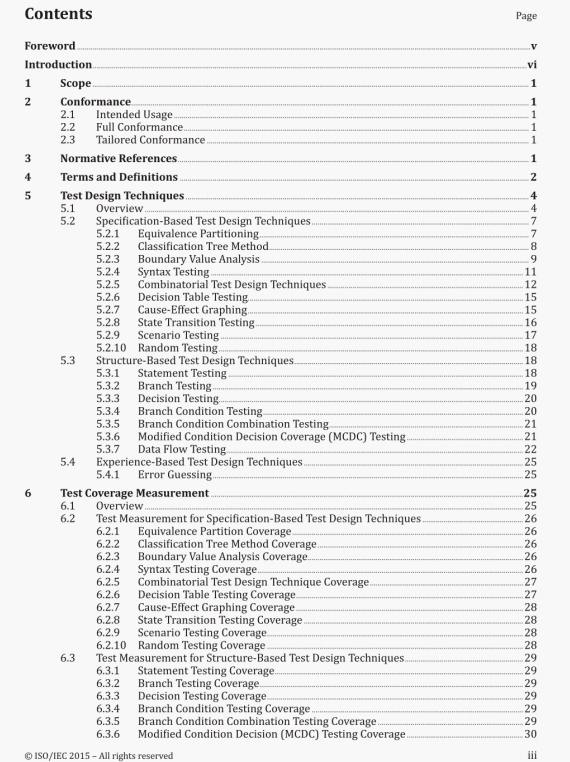IEEE 29119-4:2015 pdf free download.Software-and-systems-engineering—Software testing-
Part 4: Test techniques.
5.2.7.2 Derive Test Coverage Items (TD3)
In cause-effect graphing, each decision rule, which defines the relationship between a unique
combination of the test Item’s causes and effects, Is a test coverage Item.
5.2.7.3 Derive Test Cases (TD4)
Test cases shall be derived to exercise the test coverage items. A corresponding decision table may be produced from the cause-effect graph and used to derive the test cases. The following steps shall be used during test case derivation:
a) Select test coverage Item(s) to be implemented In the current test case;
h) Identify input values to exercise the lest coverage item(s) to be covered by the test case and
arbitrary valid values for any other Input variables required to execute the test case;
c) Determine the expected result of the test case by applying the input(s) to the cause-effect graph and/or decision table;
d) Repeat steps a) to c) until the required level of test coverage is achieved,
5.2.8 Stale Transition Testing
5.2.8.1 Derive Test Conditions (TD2)
State transition testing (BS 7925-2:1998, Copeland 2004) uses a model of the states the test item may occupy, the transitions between states, the events which cause transitions and the actions that may result from the transitions. The states of the model shall be discrete, identifiable and finite in number. An individual transition may be constrained by an event guard, which defines a set of conditions that must he true when the event occurs, in order for the transition to occur. In state transition testing, the test conditions may be all states of the state model, all transitions of the state model or the entire state model, depending on the coverage requirements of testing. The model may be represented as a state transition diagram or a state table (although other representations may also be used).
5.2.8.2 DerIve Test Coverage Items (TD3)
In state transition testing, test coverage items will change depending on the chosen test completion criterion and test design approach. Possible test completion criteria include but are not limited to the Follawing:
— states, in which test coverage items shall be derived to enable all states in the state model to be vislted”;
— single transitions (0-switch coverage), in which test coverage items shall be derived to cover valid single transitions in the state model;
— all transitions, in which test coverage items shall be derived to cover both valid transitions in the state model and invalid” transitions (transitions from states initiated by events in the state model for which no valid transition is specified);
— multiple transitions (N-switch coverage), in which test coverage items shall be derived to cover valid sequences of N+1 transitions in the state model.
NOTE 1 switch coverage is a popular variant of N’switch coverage that requires pairs of transitions to be exercised.
IEEE 29119-4:2015 pdf free download
